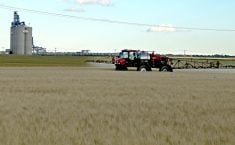Domesticated potatoes’ wild cousins can cause major weed problems in South America, but they are also sources of tough genes
Every crop you can name that we grow for food or fibre originated with a natural wild ancestor, whether it be cereals, oilseeds, pulse crops, fruit, vegetables or cotton.
Potatoes, for example, are the world’s fifth largest crop. The countless varieties that have been developed are based on about 100 wild potato species.
Plant breeders call these native ancestors “crop wild relatives,” and the Crop Science Society of America recently celebrated Crop Wild Relative Week.
Shelley Jansky, a potato breeder with the U.S. Department of Agriculture at the U.S. Potato Gene Bank in Sturgeon Bay, Wisconsin, stresses the importance of wild potatoes.
Read Also

New coal mine proposal met with old concerns
A smaller version of the previously rejected Grassy Mountain coal mine project in Crowsnest Pass is back on the table, and the Livingstone Landowners Group continues to voice concerns about the environmental risks.
She said wild potato species are a genuine weed control problem for farmers in the South America, especially in the Andes Mountains, where they grow in agricultural fields, roadsides, forests, grasslands, beaches, alpine meadows and even in the knotholes of oak trees.
The Potato Gene Bank maintains a large collection of wild and cultivated potatoes, and Jansky’s job is to identify useful genes in the bank and harness them so breeders can integrate them into their variety development programs.
“As you can imagine, wild potatoes must grow in these stressful environments without the aid of fertilizer, irrigation or pesticides,” she said.
“Consequently, they are rich in genes that are useful for potato improvement, especially stress tolerance.”
She said villagers in the Andes eat potatoes daily as part of their native diets. They have selected for diverse tastes, textures and cooking qualities. These species are valuable sources of genes for culinary traits in North America.
“My favorite wild potato, Solanum chacoense, carpets regions of the Chaco province of northern Argentina,” Jansky said.
“It is one of the most broadly adapted wild potato species and has been collected extensively by scientists around the world. It carries a broad array of genes of interest to potato breeders.
“One clone in my program, named C545, has S. chacoense as a maternal grandparent. Another wild potato, S. berthaultii, is a paternal grandparent. C545 has resistance to several important diseases, including Verticillium wilt, potato virus Y, soft rot, common scab and early blight.”
She said Solanum berthaultii is another wild potato important for breeding. It grows on forested and brushy hillsides from southern Bolivia to northwestern Argentina and is named after the French agronomist Pierre Berthault.
“The most characteristic feature of S. berthaultii is the production of sticky hairs on its leaves,” she said.
“For this reason, it has been used as a source of insect resistance. The varieties ‘Prince Hairy’ and ‘King Harry’ are two specialty varieties with insect resistance genes from S. berthaultii.
“Our most Verticillium wilt resistant breeding line, C287, features S. berthaultii as a grandparent on both sides of its pedigree. Wild potatoes typically produce small dime-sized tubers, but hybrids between cultivated potatoes and S. berthaultii often produce large, beautiful tubers.
“When I was a graduate student a few decades ago, I created and selected two clones that I named S438 and S440. These selections have S. berthaultii as a grandparent and have been used extensively as a source of improved processing quality in the development of new potato varieties.”
Jansky said crop wild relatives also contribute traits related to cooking and processing. S. chacoense is a great-grandparent of the cultivar Lenape, credited for laying the foundation for the development of cultivars used in making potato chips.
“One type of South American cultivated potato is colloquially known as Phureja,” she said.
“These common land races are incredibly diverse for tuber traits such as skin color, flesh colour, shape, size, and eye depth. Some Phureja selections produce tubers with very deep yellow flesh. Yukon Gold potatoes have Phureja as a grandparent.
“Phureja varieties have been selected by South American farmers not only for unique tuber traits, but also for exceptional culinary quality. Our best sources of genes for improved flavour have been found in Phureja, which produces tubers that are more flavourful, creamy and savoury than standard potato varieties.
“Those of us who are impatient cooks might also be interested to know that some Phureja varieties are done in half the normal time needed to boil potatoes.”


















